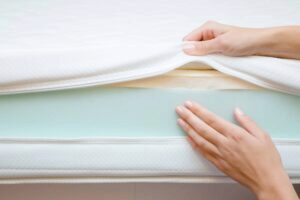Our Review Process
Disclosure: By clicking on the product links in this article, Mattress Nerd may receive a commission fee at no cost to you, the reader. Read full disclosure statement.
We determine the overall score for every mattress we test by averaging together the scores of seven performance factors: motion isolation, pressure relief, ease of movement, edge support, temperature regulation, and durability. Each of these tests results in a performance score out of 5, with 5/5 being the best and 0/5 being the worst.
The grading of these performance factors takes place in our mattress lab with several of our editors and certified sleep science coaches present. Based on these scores, we can make informed recommendations on the best mattress for you based on your individual sleep preferences.
Mattress Performance Factors
Motion Isolation
Motion isolation measures a mattress’s ability to prevent movement from reverberating across the surface. Meaning a mattress with a high score in this field can better prevent your sleep partner’s tossing and turning from disturbing you throughout the night.
If you regularly share your bed with a partner or pet, you’ll want to look for mattresses with a high score in this category. For some great options, take a look at our best mattresses for couples page.
Ease of Movement
A mattress that is highly responsive rolls with the changes, so to speak. It allows you to move around with ease and settle into new positions comfortably and quickly. Not only is this important for sleepers who like to toss and turn throughout the night, it’s also important for sex. Innerspring and hybrid mattresses tend to exhibit the highest responsiveness scores, but foam materials have also come a long way in solving for slow responsiveness.
For more info, head over to what responsiveness means in a mattress.
Pressure Relief
Pressure relief refers to the comfort and support that a mattress provides to sensitive areas of the body such as the shoulders and hips. A good score in this category can contribute to the mitigation or even prevention of aches and pains. Just about every kind of sleeper can benefit from a mattress that provides good pressure relief, but particularly seniors and people who are prone to hip and shoulder pain.
For more information, take a look at our best mattresses for shoulder pain and best mattresses for hip pain.
Edge Support
Edge support measures the sturdiness of a mattress’ perimeter. This factor is important because the sturdier the edges, the less likely they are to collapse under your weight if you roll too far over. For a deeper explanation, check out our article on what edge support in a mattress means.
Temperature Regulation
Many people don’t know this, but some mattresses actually sleep cooler than others, so your thermostat might not be the issue if you often overheat in your sleep. All-foam beds, for example, tend to trap heat in their thick layers, making your sleep experience warmer overall.
Innerspring mattresses, on the other hand, have higher breathability, and thus are usually better at dissipating heat. That said, we have found plenty of foam beds that keep exceptionally cool and plenty of innersprings that do not, it really comes down to quality of materials and construction.
For mattresses with great temperature regulation, check out our best cooling mattress page.
Durability
If you hope for your mattress to last upwards of ten years, then you’ll want to look for a high durability score. High marks in this field indicate solid construction that will hold up well under large amounts of weight. See our best mattresses that won’t sag page for more info on durability.
More Things We Consider
In addition to these seven performance factors, we take a number of other things into account when writing our mattress reviews. Price of the product, customer service, spinal alignment, ease of set-up, and return policies are just a few more of the things we think about when putting an article together.


